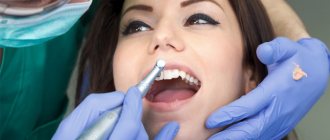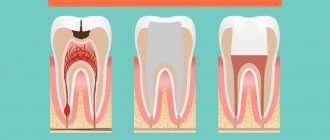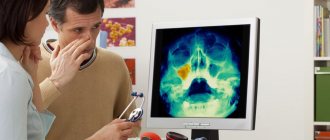When deletion is indicated
Modern dentistry strives to preserve teeth and their roots whenever possible, but this is not always possible. Dental surgeons remove teeth with cysts for the following indications:
- the infectious process was caused by an advanced form of periodontal disease;
- there is a vertically located crack on the root of the tooth or on itself;
- the dental root canals are impassable, as a result of which therapeutic treatment becomes impossible;
- severe tooth decay, and restoring it does not make sense (too expensive and time-consuming);
- the tooth is located entirely in the cavity of the neoplasm;
- the cyst has grown into the nasal cavity, or the size of the tumor is more than 10 mm;
- the root of the tooth has fused with the neoplasm;
- the tooth is very loose.
The dentist decides to remove a tooth with a cyst after a thorough examination of the patient, which includes examination, history taking, radiography or visiography.
Tooth cyst: causes and consequences
The immediate cause of a dental cyst is an infection that has entered the root canals. The reason contributing to the hit may be:
- tooth injury;
- poor quality treatment;
- periodontitis;
- pulpitis;
- diseases of the nasopharynx (tonsillitis, sinusitis, etc.);
- poorly installed crown (food gets under it);
- complications with cutting wisdom teeth;
- reduced immunity;
- congenital tendency to form cysts.
The consequences of an neglected cyst are quite severe. If you do not consult a specialist in time, an untreated dental cyst can lead to the destruction of tooth roots, which can lead to the loss of the teeth themselves, as well as gumboil, osteomyelitis, phlegmon, sepsis and, worst of all, cancerous tumors. Under no circumstances should you delay going to the doctor. Inflammation detected in time is easier to treat and does not have serious consequences.
Removing a tooth with a cyst: does it hurt or not?
In the “Optimal Choice” dental clinics, when removing teeth with benign formations at the roots, the latest anesthetics and modern equipment are used. Therefore, patients do not need to be afraid of anything at all. The doctor selects anesthetics on an individual basis; in some cases, general anesthesia may be recommended (we do not use it). Minor pain may occur after tooth extraction, when the anesthesia wears off. To relieve pain, your doctor may prescribe painkillers.
Types of deletion
A dental cyst can be treated using one of the following surgical methods:
- Cystectomy is the most common way to remove cysts on teeth. During this operation, an incision is made on the gum, through which both the benign neoplasm and the apex of the tooth root with pathology are removed. The cystectomy procedure is usually performed under local anesthesia, after which the doctor prescribes antibiotics to the patient.
- Hemisection - this type of removal is used if a tooth with a cyst has more than one root, and at least one of them is pathologically changed. During this procedure, the cystic formation, the root of the tooth with pathology, and part of the tooth itself are removed. After this operation, a crown is placed on the tooth.
- Cystotomy is the most gentle type of surgical treatment for dental cysts, in which the doctor removes only the front wall of the tumor. The tooth body is completely preserved.
These techniques are an alternative to the complete removal of teeth with cysts. But it is not always possible to apply them. To completely remove teeth with benign tumors, the extraction method is used. The operation can be performed urgently or planned.
Consequences of the appearance
The consequences can be very diverse, ranging from destruction of tooth roots to the formation of cancerous tumors. Periodically, the gingival cyst becomes active, becomes inflamed, gumboil forms on the cheek, the patient’s general condition worsens sharply, and severe toothaches and headaches appear. Moreover, even banal hypothermia, a cold, or severe stress can become an impetus for exacerbation of the disease.
If the cyst is not detected in a timely manner and it has grown greatly, destroying the jaw, even a spontaneous fracture of the jaw may occur. Fortunately, this happens extremely rarely, and you can avoid such consequences by systematically visiting a dentist and checking the condition of your teeth.
If pyogenic bacteria penetrate into the cavity of the cyst, an acute inflammatory process may occur, which threatens the occurrence of osteomyelitis and forms a fistula on the gum or cheek, through which purulent exudate flows out.
Patients are also interested in whether a malignant dental cyst can occur. In fact, it is a benign formation and in itself does not pose a direct threat to the patient’s life. But over time, if left untreated, it can cause cancer. Therefore, the formation of a granuloma or cyst should not be taken lightly.
What are the stages of the operation?
The procedure consists of the following steps:
- The desired area is numbed using conduction or infiltration anesthesia.
- The gum is peeled off from the wall using a rasp.
- The tooth is loosened and removed using forceps or an elevator.
- The dental unit is removed from the socket. In difficult cases, the tooth is first sawed into pieces using a drill, and then each of them is removed separately.
- The extracted tooth and socket are examined by a doctor.
- The cyst cavity is cleaned, and the wound is treated with antiseptic drugs.
- The wound is stitched up.
- Using an X-ray examination, the doctor makes sure that fragments, particles of the tooth and the removed tumor do not remain in the jaw.
- Antibiotics, anti-inflammatory drugs and anesthetics are prescribed.
Two to three days after the operation, you need to re-visit your dentist to monitor the condition of the tooth socket.
How is tooth root resection performed?
The meaning of the resection operation is to cut off the apex of the tooth root with a drill along with the “purulent sac”. And many patients are therefore immediately interested in the question of how long the tooth will last after resection. It must be said that the operation does not affect the service life of the tooth in any way, because The size of the root part to be removed is very small.
Tooth root resection is a fairly simple operation and usually lasts from 20 to 40 minutes. The front teeth are operated on faster, which is due to the convenience of visual control of the operation, but the lateral teeth (6-7 molars) require more effort and time from the doctor. In the animation below you can see all the main stages of the operation.
Tooth resection: animation
Preparing for surgery –
Tooth resection can be carried out only if there is no active purulent inflammation in the area of the root apex. If there is swelling of the gums or pain when pressing on a tooth, you must first remove the active inflammatory process.
The essence of preparation for surgery is high-quality filling of the root canal (Fig. 4). If resection is planned as the final stage of therapeutic treatment of chronic periodontitis, then the root canal is filled no more than 1 day before surgery (24stoma.ru). It is important that the canal is very tightly filled with a filling substance (for example, gutta-percha), because if the obstruction of the canal is not dense, the granuloma/cyst will then appear again.
If the operation is planned on a tooth where the root canals have already been filled, then the strategy may be different. For example, if the canal of this tooth is well sealed along its entire length (except at the very top of the root), it is not necessary to unseal such a canal, because the top will still be cut down. In all other cases, root canal refilling will be required.
Operation technique –
The operation is performed under local anesthesia and is absolutely painless. Moderate pain occurs only after the operation is completed, which will require taking painkillers. Below you can see the progress of the operation in detail on schematic images and videos, but first we will draw your attention to the main points during the operation.
Main stages of the operation –
Creating access to the root apex - the gum is dissected and moved away from the bone in the projection of the root apex of the causative tooth. After this, a “window” is drilled into the bone with a drill, through which the apex of the root is cut off and the granuloma or cyst is scraped out (Fig. 4b).- Root resection and cyst removal - through a hole created in the bone, the surgeon cuts off the tip of the root and scrapes out a chronic source of inflammation (this can be a granuloma or a cyst). The latter differ from each other only in size. The cyst shell must be removed completely, because if you leave even a small fragment of it, the cyst will form again.
- Suturing the wound - after antiseptic treatment of the wound, the edges of the gum mucosa are put in place and the wound is sutured. In good clinics, immediately after the operation the patient will be given ice to hold, pressing it to the cheek in the projection of the operation (this will reduce the amount of swelling). The stitches are removed after 8-10 days.
Operation diagram (Fig. 5-10) –
If the cyst was large, then bone healing can be stimulated with special osteoplastic materials based on synthetic hydroxyapatite - the preparations “Kolapol” or “Kollapan”. In some cases, retrograde root canal filling may also be used during resection surgery (see below).
Possible complications
Among the common consequences of removing a tooth with a cyst may be the following complications:
- slight increase in body temperature;
- migraine;
- soft tissue swelling;
- toothache.
In order to alleviate the patient's condition, symptomatic treatment is prescribed.
If the doctor is insufficiently qualified or the patient does not comply with medical recommendations, the following complications may arise as a result of surgical intervention:
- infectious process in tissues;
- injury to nerve endings;
- profuse bleeding.
To avoid this, you must contact only trusted dentists with good experience and clinics with modern equipment, and also follow all recommendations given by your doctor.
Preventive measures
To ensure tissue healing proceeds faster and serious complications do not arise, a number of recommendations must be followed. Dentists at the Optimal Choice clinic give the following advice to their patients:
- For several days after surgery, rest is required; any physical activity (even light) is contraindicated;
- avoid hot water procedures, including baths, steam baths, saunas, and do not use hot compresses;
- You cannot use active mouth rinses for 2-3 days; if necessary, they can be replaced with oral baths with infusions or decoctions of medicinal herbs (with oak bark, calendula, eucalyptus, sage), furatsilin, chlorhexidine, etc.;
- do not drink alcoholic beverages or smoke for 2-3 days;
- Taking medications prescribed by a doctor is mandatory.
Compliance with these rules, as well as regular visits to the dentist for preventive examinations and at the slightest unpleasant symptoms, will allow you to avoid serious negative consequences and significant financial expenses for dental services.
Sedation - cyst treatment in absolute comfort
Rescue for patients with dental phobia and during large-scale work that requires a long stay in an uncomfortable position
- Fears, physical and psychological discomfort are excluded
- Sedatives do not carry any burden on the body
- Easy “exit” after treatment, after 30 minutes you can go home
Experts' opinion
Question: Is it possible to avoid the occurrence of a cyst on a tooth?
Answer : The etiology of the formation of a cyst at the root of a tooth can be different. At the initial stages, treatment of this pathology does not pose a serious problem. Therefore, it is very important to be regularly examined by a dentist, and also to take x-rays or visiography at least once a year to identify any pathologies of the dental system. New growths, if present, will also be visible on the images. To reduce the likelihood of tumors appearing, if any diseases of the oral cavity and nasopharynx occur, it is necessary to treat them in a timely manner: develop the habit of regularly rinsing your mouth with antiseptics, and learn to brush your teeth correctly. Maintaining a healthy lifestyle, a balanced diet, a strong immune system and preventive dental examinations are the key to dental health.
Question: Is it possible to get rid of a cyst on a tooth at home on your own?
Answer : We do not recommend self-medication if you have any pain or unpleasant symptoms in the oral cavity. Any discomfort may be a sign of a serious illness that requires medical attention. If it is not possible to urgently visit the dentist, then to reduce pain you can use the following rinses: herbal decoctions (yarrow, calendula, sage, chamomile, oak bark), a solution of baking soda or salt, vodka, tea tree essential oil. This may help reduce pain, but in any case you should see a doctor as soon as possible.
Why does a cyst appear at the site of an extracted tooth?
The neoplasm is a hollow capsule of dense tissue filled with serous or purulent contents. It occurs as a response of the body to an infection to limit its spread. Thus, the main reason for its appearance is pathogenic microflora.
Provoking factors:
- Tissue infection during nerve extraction or removal. This may be insufficient antiseptic treatment of the surgical field, unsterile instruments, or other doctor’s shortcomings during the procedure.
- The tooth was removed, but the cyst remained. This option is possible if the necessary diagnostics were not carried out and the doctor simply did not notice the pathological formation.
- Dry hole. After extraction, a blood clot is formed, which protects deep tissues from the penetration of bacteria and food debris. If the blood plug comes off or falls out, the opened cavity becomes the center of an accumulation of pathogenic organisms, which become provocateurs of pathology.
- Medical errors during implantation. If the implant is installed soon after removal, infection and capsule formation may also occur during the procedure.
- Failure to follow the doctor’s recommendations during the rehabilitation period. If the patient is negligent about his health, the risk of developing inflammatory processes increases.
Neglecting antibiotic therapy can ultimately cause a purulent infection. A dry socket is formed due to intensive rinsing of the mouth and licking of a blood clot. If the patient smokes or abuses alcoholic beverages, the wound in the mouth does not heal well, which means the risk of complications increases.










